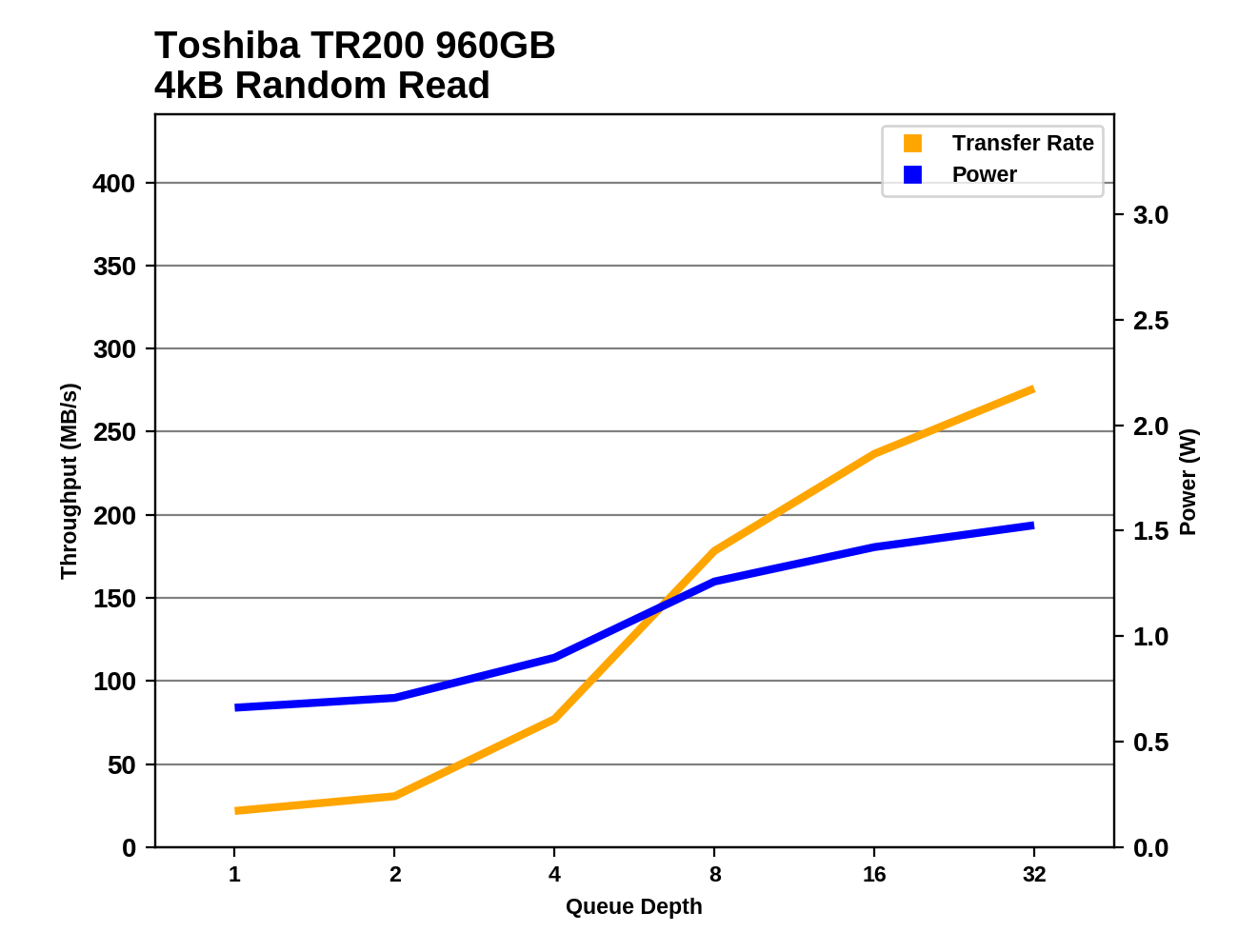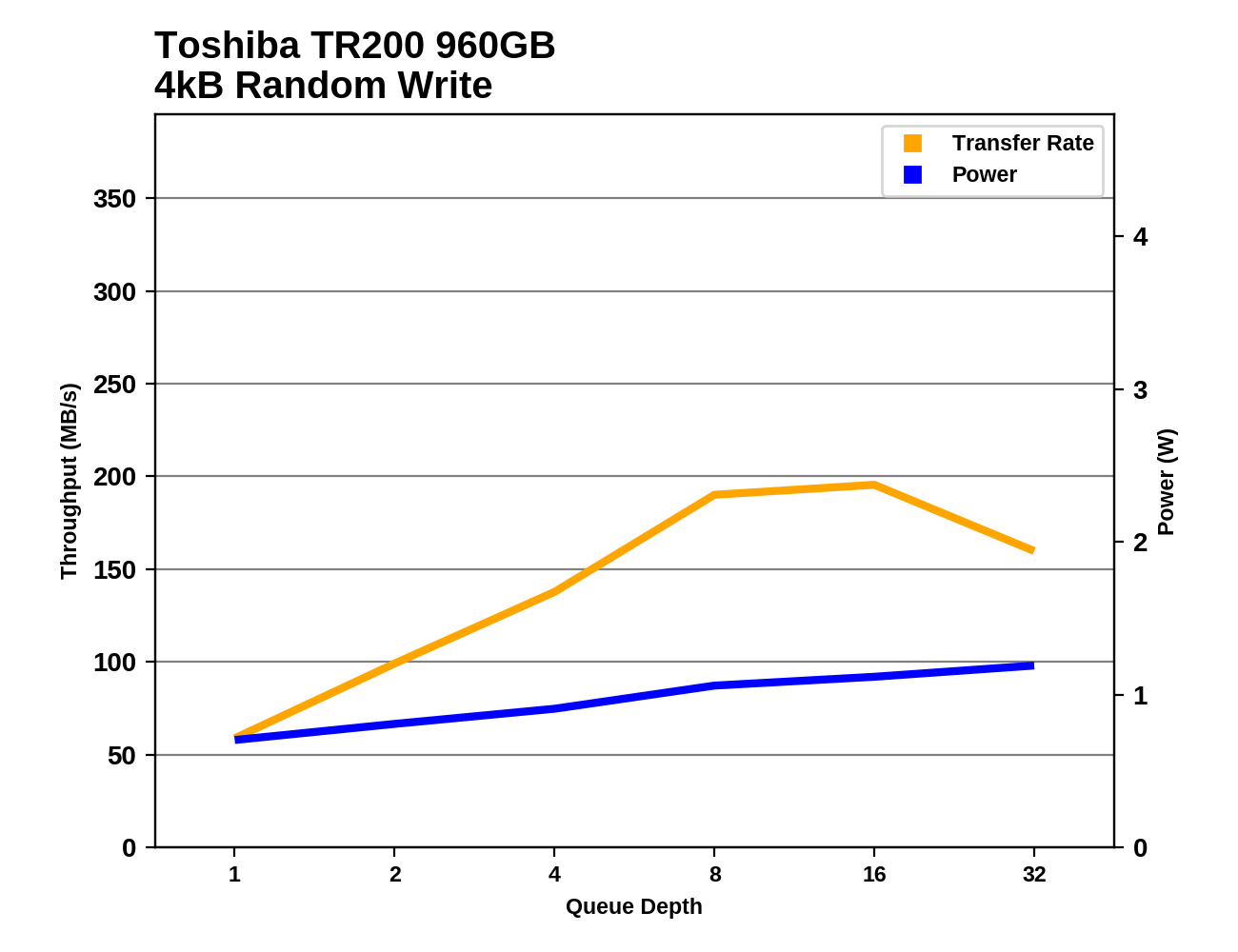The Toshiba TR200 3D NAND SSD Review: One Step Forward, One Step Back
by Billy Tallis on October 11, 2017 7:00 AM ESTRandom Read Performance
Our first test of random read performance uses very short bursts of operations issued one at a time with no queuing. The drives are given enough idle time between bursts to yield an overall duty cycle of 20%, so thermal throttling is impossible. Each burst consists of a total of 32MB of 4kB random reads, from a 16GB span of the disk. The total data read is 1GB.

The QD1 burst random read speeds of the Toshiba TR200 are mostly normal for a budget SSD, though the 960GB model is notably slower than the smaller capacities that are using the 256Gb NAND dies instead of the 512Gb dies.
Our sustained random read performance is similar to the random read test from our 2015 test suite: queue depths from 1 to 32 are tested, and the average performance and power efficiency across QD1, QD2 and QD4 are reported as the primary scores. Each queue depth is tested for one minute or 32GB of data transferred, whichever is shorter. After each queue depth is tested, the drive is given up to one minute to cool off so that the higher queue depths are unlikely to be affected by accumulated heat build-up. The individual read operations are again 4kB, and cover a 64GB span of the drive.

On the longer test that includes higher queue depths, the Toshiba TR200 falls to near the bottom of the chart. The 240GB and 960GB models are substantially slower than anything else we've tested of similar capacity. On the other hand, the 480GB TR200 is tied with the 525GB Crucial MX300, and the trend suggests that the 275GB Crucial MX300 would score a bit worse.

The power efficiency of the Toshiba TR200 during random reads is good, and a clear improvement over the TR150. Notably, the 960GB TR200 scores about the same as the SanDisk Ultra 3D 1TB, showing that the latter's higher performance is in proportion to the power cost of its DRAM.
 |
|||||||||
The TR200s all show very little random read performance increase from QD1 to QD2, and this is most of why their performance scores above are so low. Through the mid range of queue depths, the TR200 shows better scaling than many other budget SSDs, but at the high end the performance increases taper off. The 960GB model never provides substantially higher performance than the 480GB model, as both have the same number of NAND dies.
Random Write Performance
Our test of random write burst performance is structured similarly to the random read burst test, but each burst is only 4MB and the total test length is 128MB. The 4kB random write operations are distributed over a 16GB span of the drive, and the operations are issued one at a time with no queuing.

The Toshiba TR200s are the slowest drives for short bursts of random writes at QD1. The larger drives are slower, a pattern that the TR150 and several other models exhibit.
As with the sustained random read test, our sustained 4kB random write test runs for up to one minute or 32GB per queue depth, covering a 64GB span of the drive and giving the drive up to 1 minute of idle time between queue depths to allow for write caches to be flushed and for the drive to cool down.

On the longer test of random writes involving some higher queue depths, the gap between the TR200 and a typical mainstream SATA SSD widens to a factor of two or more, but the TR200 also ends up ahead of the HP S700 and the original Trion 100.

In spite of the poor sustained random write performance, the Toshiba TR200 shows above average power efficiency. This is a huge change relative to previous Trion/TR series drives, which were the least efficient drives on this test. The HP S700 also showed very poor efficiency during random writes.
 |
|||||||||
The 960GB TR200 shows steady performance scaling as queue depths increase, but by the end of the test its SLC cache has filled up and performance begins to drop. The smaller TR200s also saturate by around QD8 and hold steady at very low performance levels. Power also stays low even at higher QDs, with the 240GB model never exceeding 1W.










50 Comments
View All Comments
HollyDOL - Wednesday, October 11, 2017 - link
Have to admit, 250GB is enough so far, but it's tight, my next SSD will be at least 500GB for sure.yankeeDDL - Wednesday, October 11, 2017 - link
For XBONE and PS4 SSD make no sense, IMHO: you need large storage space, and speed is (nearly) irrelevant.At $89,99 you buy 3TB HDD (and some 4TB on discount) which will perform identically when connected via USB, but offer more than 10X the storage.
250GB SSD are nearly useless: just barely as a boot disk if the performance is "good", which it isn't in this case.
takeshi7 - Wednesday, October 11, 2017 - link
As someone who uses an SSD in their PS4 and Xbox One, I think it's worth it, but it definitely depends on the game. Forza and Elder Scrolls Online loads so much faster off of an SSD compared to a hard drive I've probably saved hours of loading screens. But in Destiny you have to wait for the servers and I've found an SSD doesn't cut as much time off of the loading screens.rrinker - Wednesday, October 11, 2017 - link
My work laptop has a 500GB 850 EVO, but I also run VMs on it so I have single files that are 30GB. My new machine at home has a 500GB 850 EVO, just because. I don't game on that one, it doesn't even have a discrete video card, it's my workbench computer for electronics stuff, and the Arduino IDE and Visual Studio don't need discrete graphics. The 500GB is actually probbaly overkill, but it had been sitting on my desk for 5 months waiting for me to install it in my OTHER desktop. That one is an older machine but with a 970 it easily plays anything I play. Other than the video card, the machine is about 6 years old, originally built with a regular hard drive but then I upgraded it with a 250GB 830 EVO. It still has a spinny disk a D drive an the real space hog but not performance intensive things all go there, so so far the 250GB has been sufficient (hovers around 90GB free since upgrading to Win 10). I don't game a lot, and when I do I'm a serial gamer - one game at a time. When I get bored with that and move on to the next, I uninstall the old one.steve wilson - Thursday, October 12, 2017 - link
Would that not be more of a monogamous gamer? I'm pretty much the same, I stick with one game most of the time, up until recently. PUBG and Rocket league now.rocky12345 - Wednesday, October 11, 2017 - link
Yep you got a point the games are getting so big that 250-500GB space gets tight real fast. I have a 500GB SSD and 3 4TB drives in Raid 0+1 config which makes the mech drives perform very good. If I do find a game that takes a while to load up off of the 4TB drive config I just copy it to the SSD Drive and see very quick load times then. 2 games come to mind so far that I have done this with GTA V & Fallout 4. Both of those games see a huge boost in loading times shortened by doing this.Fallen Kell - Thursday, October 12, 2017 - link
Just trying to figure out how you are using 3 drives to do a 0+1 RAID which clearly needs 4 drives to work... I mean I guess you could have created 2 partitions on each drive and then 0+1'ed the partitions and were extremely careful in the strip'ed mirror creations such that drive 1 has mirror of drive 3, drive 2 has mirror of drive 1, and drive 3 has mirror of drive 2...Again, just wondering.
rocky12345 - Thursday, October 12, 2017 - link
Yea I just asked my friend who set it up and he said it was setup as Raid 01 hybrid 3 drive setup. He said yes 4 drives are much better for this setup. I asked him why he did not tell me this at the beginning his response "you never asked".the way he explained it was to picture it as with drive 1 with A1,A2,A3 Drive 2 with A1,A3,A4 Drive 3 with A2,A3 he even showed me a picture of this to make me see what he did and explained to me.
Now I am debating on just killing this raid setup and just making a Raid 0 config with 2 of the drive and have the third as a storage backup or picking up another 4TB drive and doing the proper configuration and not a non standard like I have now. He seems to think I should just leave it alone as it works well and the speed is good as it sits. Not sure what to do now I do not like having things done half fast...lol
rocky12345 - Thursday, October 12, 2017 - link
I just wanted to add reading your comment it looks like he may have set it up the way you said it could be done because he did say it was a bit tricky meshing it all together so it would work properly with the 3 drives only. If you think I should get a another 4TB drive and just have the raid configured again I am thinking that is the best option. I won't lose anything it is all backed up on externals anyways and whatever is not are just not worth backing up.Pork@III - Wednesday, October 11, 2017 - link
Sequential Read 555 MB/s 555 MB/s 555 MB/sSequential Write 540 MB/s 540 MB/s 540 MB/s
7 years long periood of same speed of ordinary SSD's